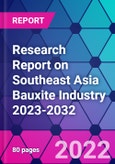Southeast Asia in this report includes 10 countries: Singapore, Thailand, Philippines, Malaysia, Indonesia, Vietnam, Myanmar, Brunei, Laos and Cambodia. With a total population of over 600 million by the end of 2021, Southeast Asia has an overall economic growth rate higher than the global average and is one of the key drivers of future global economic growth.
Due to the degree of economic development, technology level and other reasons, the mineral resources in Southeast Asia are less explored. However, as far as the proven resources are concerned, Southeast Asia is rich in mineral resources, and the main minerals include: copper, gold, nickel, aluminum, tin, titanium, antimony, silver, potash, gypsum, barite and phosphorus, as well as iron, zinc, lead, chromium, manganese, cobalt, kaolin, etc.
Bauxite is an aluminum-rich ore used in aluminum production (metallurgical bauxite) and in the production of refractory materials, chemicals or cement (non-metallurgical bauxite). According to the publisher's analysis, global bauxite ores are mainly distributed in Africa, Oceania, South America and Southeast Asia. Countries such as Vietnam and Indonesia in Southeast Asia have abundant bauxite ores.
The publisher expects that in 2023-2032, more and more foreign companies will set up bauxite and other mineral mining enterprises in Southeast Asia, and Southeast Asia's mineral exports are expected to continue to rise.
Topics covered:
- Southeast Asia Bauxite Industry Status and Major Sources in 2018-2022
- What is the Impact of COVID-19 on Southeast Asia Bauxite Industry?
- Which Companies are the Major Players in Southeast Asia Bauxite Industry Market and What are their Competitive Benchmarks?
- Key Drivers and Market Opportunities in Southeast Asia Bauxite Industry
- What are the Key Drivers, Challenges, and Opportunities for Southeast Asia Bauxite Industry during 2023-2032?
- What is the Expected Revenue of Southeast Asia Bauxite Industry during 2023-2032?
- What are the Strategies Adopted by the Key Players in the Market to Increase Their Market Share in the Industry?
- What are the Competitive Advantages of the Major Players in Southeast Asia Bauxite Industry Market?
- Which Segment of Southeast Asia Bauxite Industry is Expected to Dominate the Market in 2032?
- What are the Major Adverse Factors Facing Southeast Asia Bauxite Industry?
Table of Contents
Methodology
Background research defines the range of products and industries, which proposes the key points of the research. Proper classification will help clients understand the industry and products in the report.
Secondhand material research is a necessary way to push the project into fast progress. The analyst always chooses the data source carefully. Most secondhand data they quote is sourced from an authority in a specific industry or public data source from governments, industrial associations, etc. For some new or niche fields, they also "double-check" data sources and logics before they show them to clients.
Primary research is the key to solve questions, which largely influence the research outputs. The analyst may use methods like mathematics, logical reasoning, scenario thinking, to confirm key data and make the data credible.
The data model is an important analysis method. Calculating through data models with different factors weights can guarantee the outputs objective.
The analyst optimizes the following methods and steps in executing research projects and also forms many special information gathering and processing methods.
1. Analyze the life cycle of the industry to understand the development phase and space.
2. Grasp the key indexes evaluating the market to position clients in the market and formulate development plans
3. Economic, political, social and cultural factors
4. Competitors like a mirror that reflects the overall market and also market differences.
5. Inside and outside the industry, upstream and downstream of the industry chain, show inner competitions
6. Proper estimation of the future is good guidance for strategic planning.

LOADING...








